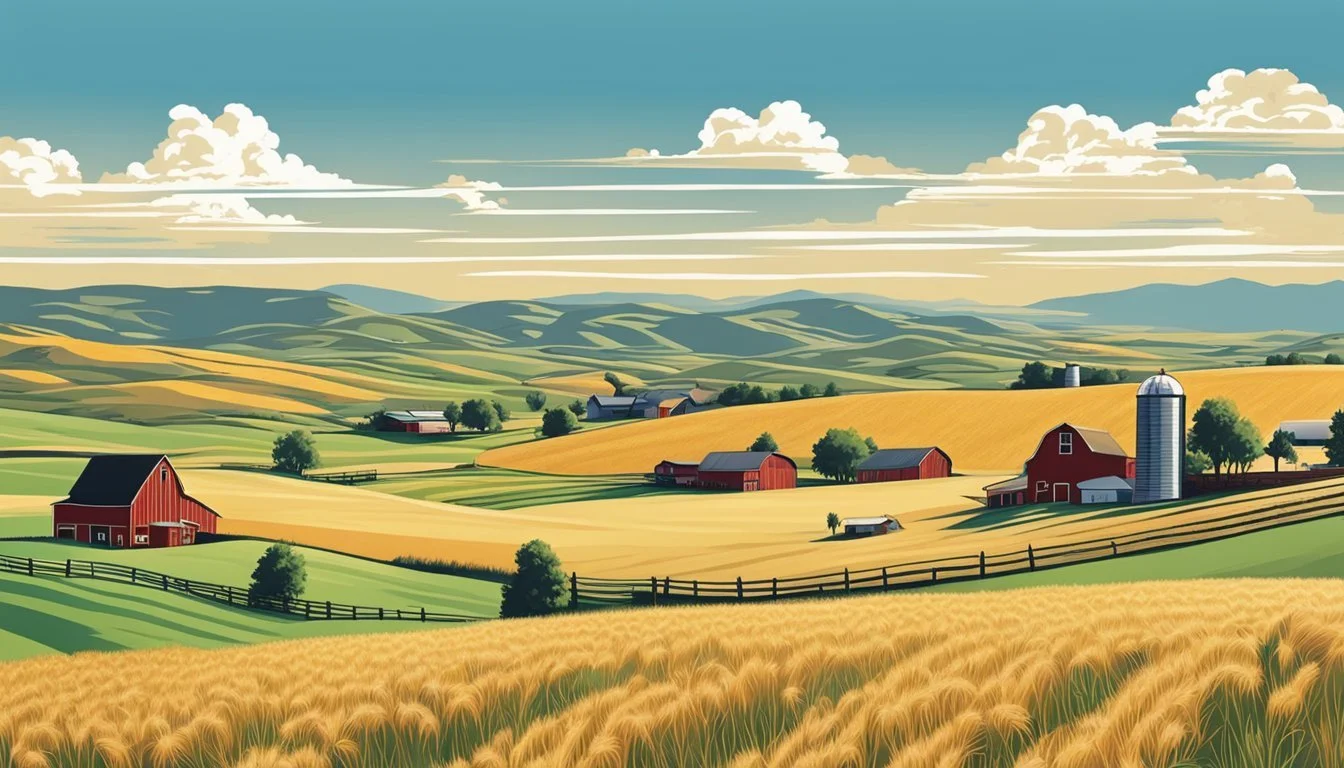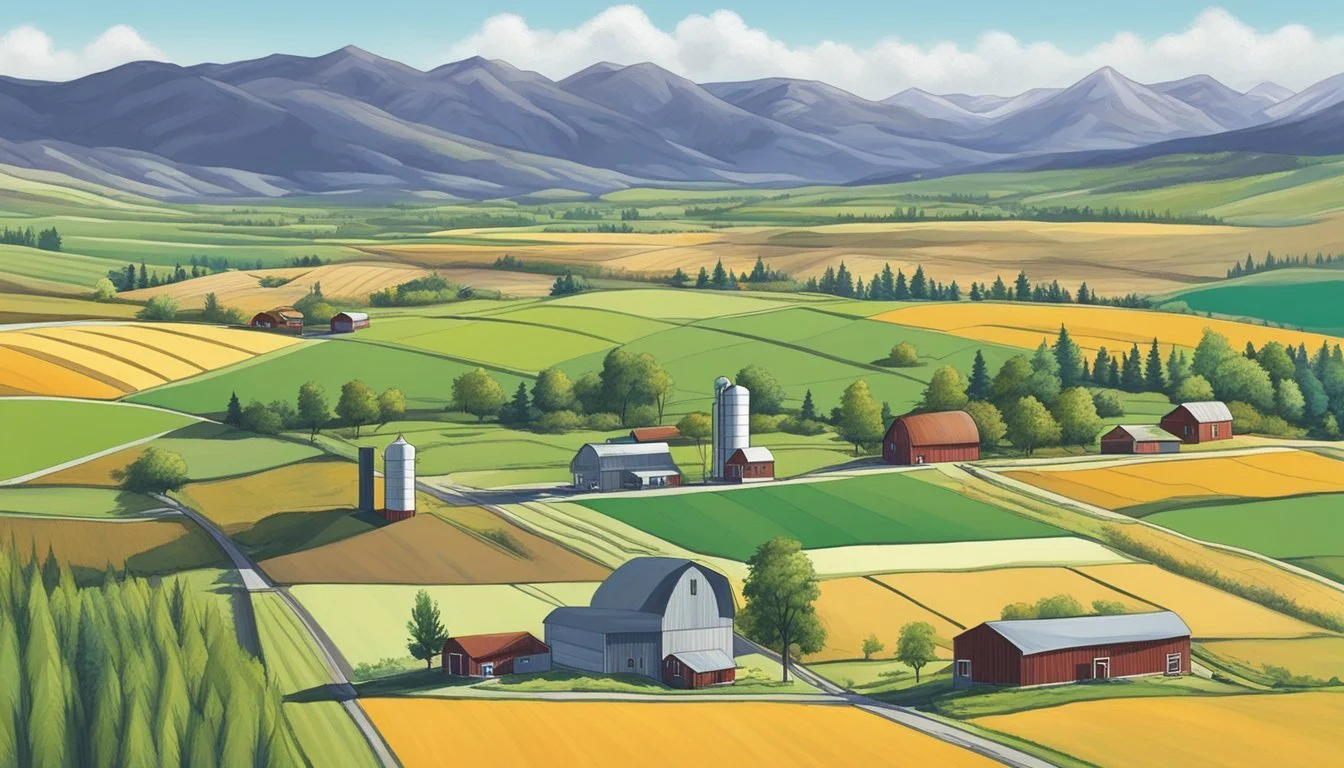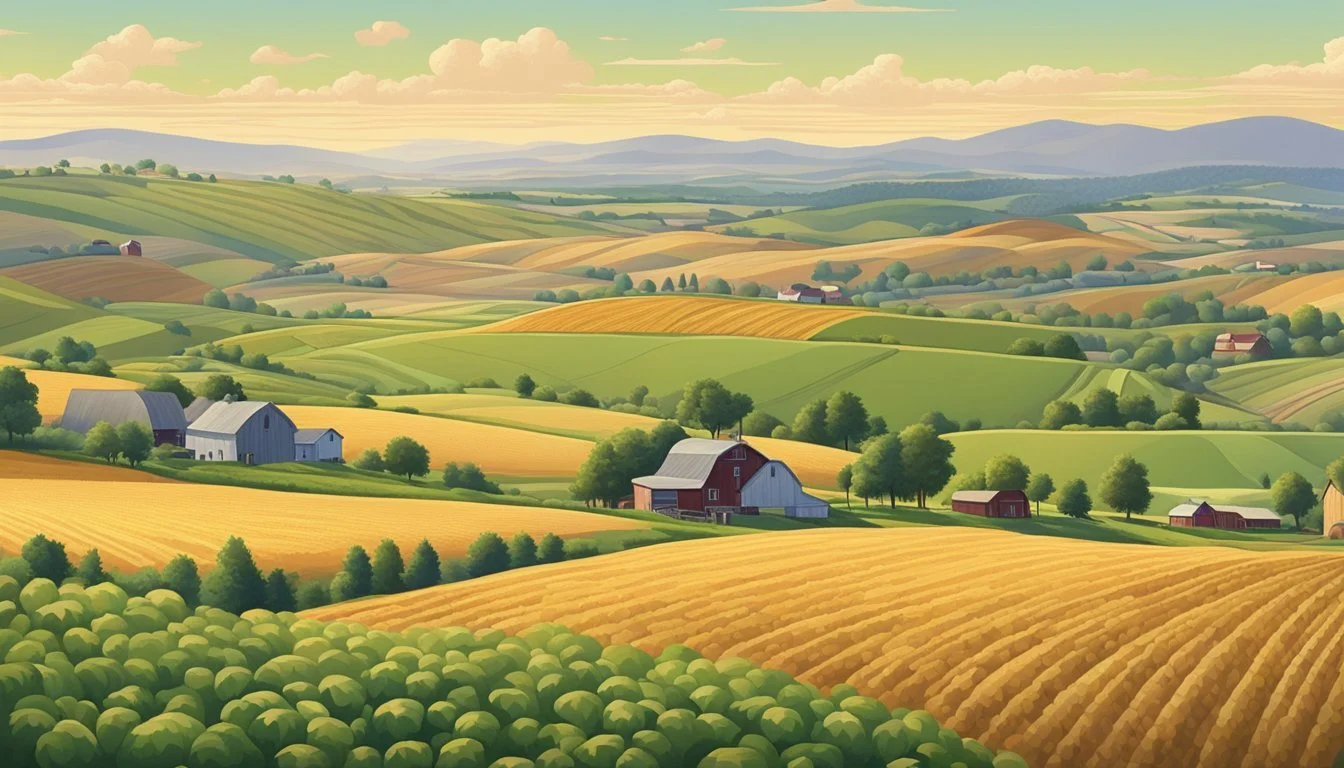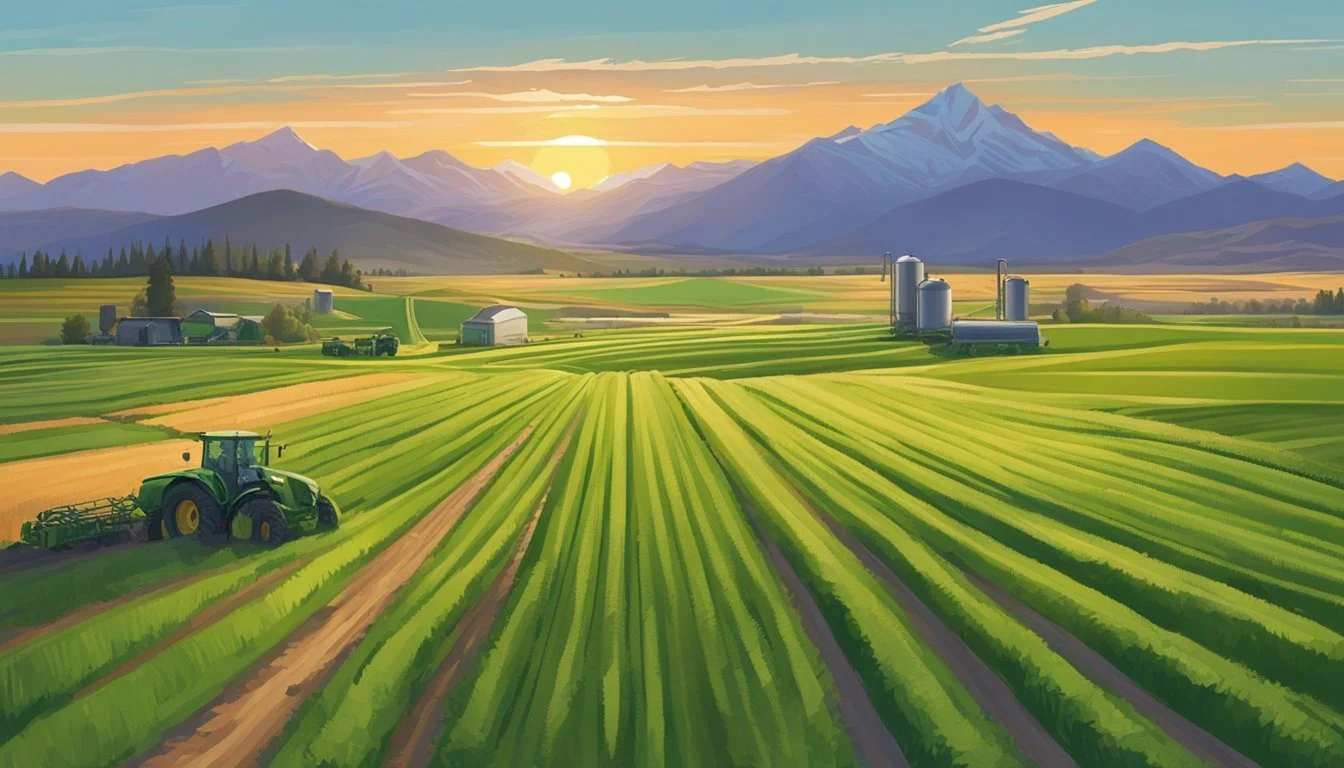Farming Communities in Idaho
Driving Agricultural Innovation
Nestled in the picturesque landscapes of Idaho, farming communities offer a unique glimpse into a lifestyle rooted deeply in tradition and agriculture. These communities, such as Grace in southern Idaho, are home to residents who take pride in their agricultural heritage and communal bonds. Grace, with approximately 1,000 residents, is surrounded by natural wonders like the Niter Ice Cave and Black Canyon, making it a hidden gem in Idaho's rural landscape.
Idaho's farming communities are not just significant for their scenic beauty but also for their contribution to the state's economy. The state is rich with farms and ranches, with properties like the River Run Ranch showcasing prolific western lifestyles along the Snake River. Large tracts of farmland and ranches are on the market, emphasizing Idaho's prominence in agricultural real estate.
These farming areas extend beyond simple living; they include substantial economic activities through family farms, organic farming, and land preservation. With Idaho's farmland market featuring significant acreage and high-value properties, the rural parts of the state hold an intrinsic value for both their economic output and their cultural heritage.
History of Farming in Idaho
Idaho's agriculture has deep roots, marking the state's development and identity. Early practices laid the foundation for modern growth, showcasing significant advancements in crop and livestock production.
Early Farming Practices
In the mid-19th century, the first settlers began cultivating Idaho's fertile land. These pioneers faced numerous challenges, including harsh weather and limited access to resources.
Farmers from Washington migrated into Idaho's Palouse country post-1870. This led to burgeoning farming communities, including Moscow. The development of irrigation systems played a key role in increasing agricultural productivity.
By 1920, there were over 42,000 farms, highlighting the significant agricultural expansion during this period. Early practices were diverse, spanning crop farming, cattle ranching, and fruit orchards.
Modern Agricultural Developments
Modern agriculture in Idaho represents a blend of tradition and innovation. Today, Idaho boasts over 24,000 farms, with nearly two-thirds being small, part-time operations.
The state’s farmers utilize advanced technology, from GPS-guided equipment to sustainable farming practices. This ensures high efficiency and productivity. Over recent years, Idaho's agricultural exports have doubled, underscoring its vital role in global trade.
Idaho produces a diverse array of crops, including potatoes, barley, and sugar beets. Dairy farming is also prominent, contributing significantly to the state's economy. This balance between crop and livestock farming showcases the continued evolution of Idaho's agricultural landscape.
Geography of Idaho Farmland
Idaho's farmland is shaped by its diverse terrain, including its valleys and significant water bodies. These factors play a crucial role in agricultural productivity.
Valley Regions and Farming
Idaho boasts several valley regions ideal for farming. The Teton Valley, known for its rich soil, supports a range of crops, primarily potatoes and grains. Owyhee County, with its expansive valleys, is another prominent agricultural area. The Snake River Plain, a key farming region, provides fertile soil and a favorable climate.
The Canyon County area is also significant, leveraging the benefits of its valley location for farming. These valleys offer suitable conditions for both large-scale and small family farms.
The Role of Water Bodies in Agriculture
Water sources are vital for Idaho's agriculture. The Clearwater River in northern Idaho contributes to the area's farming success by providing essential irrigation.
Irrigation is especially crucial in southern regions, where the Carey Act facilitated the development of irrigation systems, transforming arid land into productive farmland. The Snake River, a major water source, supports extensive irrigation networks across its plain.
Water management through reservoirs and canals ensures that even in dry seasons, farms have a reliable water supply. This structured irrigation is essential for maintaining high yields and supporting a variety of crops across the state.
Types of Crops and Livestock
Idaho's farming communities are diverse, with a variety of crops and livestock that thrive thanks to the state's unique climate and soil conditions. The main types of crops grown include wheat and barley, while livestock farming focuses heavily on cattle and dairy production.
Cereal Crops: Wheat and Barley
Wheat and barley are staple crops in Idaho's farming economy. Wheat is grown primarily for bread, pasta, and other products. It is valued for its adaptability to the state's climate. Winter wheat and spring wheat are two main types, cultivated for their different growing seasons and uses.
Barley is another significant cereal crop, commonly used in livestock feed and brewing industries. Idaho ranks among the top U.S. states in barley production. Barley thrives in the cooler northern regions and is an integral part of crop rotation practices to maintain soil health.
Livestock Farming and Grasslands
Livestock farming is a cornerstone of Idaho's agricultural sector. The state is known for its beef cattle and dairy products. Cattle ranches cover extensive grasslands, suitable for grazing. Dairy farming is a key industry, with large-scale dairy farms producing milk, cheese, and other dairy products that contribute significantly to the economy.
Sheep and goats are also raised, though to a lesser extent than cattle. The availability of vast grasslands supports organic farming practices, allowing for the production of high-quality livestock feed. This contributes to Idaho's reputation for premium meat and dairy products.
Community and Economy
Farming communities in Idaho play a crucial role in sustaining both local societies and the state's economy. They foster a unique cultural connection and significantly contribute to economic growth and stability.
Importance of Farming to Local Communities
Farming is integral to the identity of Idaho's rural areas. In regions surrounding Boise, communities rely on farming not just for economic support but also for a sense of purpose and tradition. The Deseret News highlights that fewer than 2% of Americans work on farms today, making the agricultural lifestyle in Idaho a unique and valued experience.
Farmers and their families often share a deep connection to the land and their work, creating a close-knit community where everyone understands the value of agriculture. This communal environment supports local schools, small businesses, and social structures, ensuring that the community thrives together.
Economic Impact of Agriculture
Idaho's agriculture sector is a driving force behind the state's economy. As noted by Taylor, an economist, Idaho's farm GDP growth significantly outpaces the state's overall GDP. From 1997 to 2020, Idaho's inflation-adjusted farm GDP more than doubled, growing by over 200%.
Agriculture represents 17% of Idaho’s economic output, according to the Idaho State Department of Agriculture. This robust growth demonstrates the vital role that farming plays in economic sustainability. Sustainable agriculture practices are essential, including soil restoration and water conservation, to ensure continued economic viability. Removing financial barriers helps farmers adopt these practices, enhancing both productivity and environmental stewardship.
Community Supported Agriculture (CSA) programs also contribute economically by connecting local farmers directly with consumers, promoting local investments, and reducing reliance on external markets.
Environmental Impact and Sustainability
In Idaho, cultivating sustainable farming practices is critical. These practices aim to protect the environment while ensuring the economic viability of farming communities.
Soil Health and Conservation
Improving soil health enhances crop yields, reduces erosion, and increases water retention. In Idaho, regenerative agricultural techniques like crop rotation and cover cropping are widely adopted. These methods help restore organic matter and vital nutrients in the soil.
Cover cropping involves planting specific crops to cover the soil, preventing erosion and enriching soil fertility. Crop rotation alternates different crops in the same area to prevent nutrient depletion and disrupt pest cycles. These strategies contribute to long-term soil sustainability and resilience against climate variability.
Climate Change and Farming Adaptations
Idaho faces significant climate challenges, such as changing precipitation patterns and rising temperatures. Farmers have to adapt by implementing climate-smart practices. These include efficient irrigation systems to conserve water amidst increased droughts.
Switching to drought-resistant crop varieties helps maintain productivity despite water scarcity. Additionally, sustainable practices like reducing greenhouse gas emissions are crucial for mitigating climate impacts. These approaches help maintain agricultural productivity and protect the viability of Idaho's farming communities.
Technological Innovations in Farming
Technological advancements are transforming Idaho's farming sector, particularly in irrigation and overall agricultural practices. Enhanced techniques are enabling efficient resource usage and improved crop yields.
Advancements in Irrigation
In recent years, Idaho farmers have adopted modern irrigation systems to enhance water efficiency. Automated irrigation systems, capable of scheduling and adjusting water delivery based on soil moisture levels, have become common.
GPS-guided tractors offer precision in watering large fields, reducing waste. This technology ensures that each area receives the optimal amount of water. Drones are also utilized to monitor crops and identify areas needing attention, leading to timely interventions and better water management.
Innovative solutions like these not only conserve water but also boost crop yields and quality, addressing environmental concerns and economic efficiency.
Agricultural Technology and Practices
Idaho's agricultural landscape benefits greatly from an infusion of advanced technologies. Biotechnology plays a significant role, particularly in the development of disease-resistant seeds, which ensure healthier crops.
Virtual advisor models, such as Instacrops, assist farmers in maximizing yields and minimizing environmental impacts. By connecting processed information and making it actionable, these tools provide real-time insights.
Climate-smart practices, promoted through initiatives like the Innovative Agriculture and Marketing Partnership, are becoming standard. These practices focus on sustainability and innovation, ensuring Idaho remains at the forefront of agricultural technology.
Using these technologies, Idaho farmers not only maintain productivity but also pave the way for a more sustainable and efficient farming future.
Idaho's Land and Real Estate
Idaho's land market showcases various opportunities for potential buyers, including vast ranches and fertile farmland. Understanding the market's dynamics can significantly aid those interested in investing in the state's agricultural landscape.
Purchasing Farmland
Purchasing farmland in Idaho involves several key considerations. Location plays a pivotal role; properties along rivers like the Snake River offer fertile soil and ample water supply, crucial for farming. Interested buyers often look at sites between Boise and Twin Falls, regions known for their agricultural productivity.
Another consideration is the purpose of the land. Some may seek to operate organic farms, while others might consider using the land for recreational purposes or as family compounds. Understanding these different objectives can help narrow down the best property options.
Legal regulations and zoning laws also significantly impact purchases. Buyers should familiarize themselves with local regulations to ensure the land can be used as intended. Access to resources like water rights and road accessibility should also be thoroughly checked.
Land Prices and Ownership Trends
Land prices in Idaho vary by region and land type. Farmland listings can range substantially in price; recent data shows the average price can reach up to $1.9 million. Location, land quality, and included amenities affect these prices.
Ownership trends indicate significant interest in rural properties. Around 400,000 acres of land, including farms and ranches, are currently on the market, reflecting strong supply and demand dynamics. The combined market value of this land is nearly $8 billion, highlighting the economic significance of Idaho’s agricultural real estate.
Large estates like River Run Ranch serve multiple functions, from business headquarters to family residences. These multi-use properties often command higher prices but offer versatility and greater value over time. Being informed about market values and ownership patterns is crucial for making informed decisions in Idaho’s land market.
Legislative Framework
Idaho's legislative framework for farming communities encompasses a range of laws and regulations affecting water usage and land management. These laws ensure sustainable agricultural practices while protecting the environment and local communities.
Regulations Governing Water Usage
Water usage in Idaho farms is primarily governed by a combination of state laws and local regulations. Idaho Code Title 42 outlines the laws related to water rights, including the appropriation and adjudication processes.
The state employs a "first in time, first in right" principle, meaning those with older water rights have priority during shortages. Administrative bodies, such as the Idaho Department of Water Resources (IDWR), monitor and enforce these regulations.
Water usage is also subject to audits to ensure compliance. The state has implemented several initiatives to promote efficient water use, such as offering grants for irrigation modernization. Regulations also include strict guidelines to prevent contamination of water sources by agricultural runoff.
Land and Environmental Laws
Idaho's Right to Farm Act (Chapter 45, Title 22) protects farmers from nuisance lawsuits, provided their operations comply with existing regulations. This law is crucial for preserving traditional farming activities from the pressures of urban sprawl.
House Bill 608 aims to safeguard farmland from development by requiring counties to establish "agricultural protection areas." These zones help maintain agricultural land use and offer various protections to farmers.
Environmental regulations are enforced by entities like the Idaho State Department of Agriculture (ISDA). The ISDA focuses on reducing the environmental impact of fertilizers and pesticides. They also implement the Red Tape Reduction Act to streamline regulations, making compliance easier for farmers while ensuring environmental protection.
Legislative efforts continue to evolve, ensuring a balance between agricultural productivity and sustainability for Idaho's farming communities.
Agricultural Education and Collaboration
To strengthen farming communities in Idaho, various educational programs and collaborative initiatives have been implemented. These efforts focus on enhancing skills, promoting local food systems, and fostering partnerships within the agricultural sector.
Educational Programs for Farmers
Idaho offers a broad spectrum of educational opportunities for farmers. Programs such as Cultivating Success provide courses, workshops, webinars, and on-farm learning experiences. These programs are designed to benefit both experienced and beginning farmers as well as community members and agricultural professionals.
The University of Idaho Extension also plays a significant role through its Farm to School program. This initiative connects local foods and agriculture with schools, teachers, and students. Activities include local food procurement, agricultural education related to food, health, and nutrition, and hands-on learning through school gardens.
Collaborative Farming Initiatives
Collaboration is a key component in Idaho's agricultural sector. One notable example is the Sustainable Agriculture Research and Education (SARE) program, which has led efforts to increase the production of local food. A significant goal was set to produce 20% of the state's food locally by 2020.
Another collaborative effort is seen in the use of agricultural education advisory councils. These councils help align educational programs with community needs, encouraging cooperation between educators, farmers, and community members. Despite challenges in securing community collaboration, these councils play a vital role in advancing agricultural education and practice in Idaho.
Overall, collaborative initiatives and educational programs are essential in supporting and advancing the agricultural community in Idaho.
Demographics and Culture
Farming communities in Idaho showcase a blend of diverse populations and a deep-rooted cultural significance in agriculture, reflecting a rich tapestry of ethnic backgrounds and traditions.
Diversity in Farming Communities
Idaho's farming demographic is varied, comprising individuals from different ethnic and cultural backgrounds. The majority of farm operators are of European descent, while sizable Hispanic and Latino communities have significantly contributed to the agricultural workforce. Native American tribes, such as the Nez Perce and Shoshone-Bannock, also have a historical presence in the farming regions. This diversity is apparent in the range of crops produced and farming practices employed.
Many migrant workers also support Idaho's agriculture sector, especially during peak harvest times. Their presence underscores the importance of diverse labor in sustaining the state's agricultural output. Bilingual communication, seasonal employment patterns, and multicultural community events are integral to the social fabric of these regions.
Cultural Significance of Agriculture
Agriculture is more than an economic activity in Idaho; it is a cultural cornerstone. Local festivals, fairs, and community gatherings often celebrate the state's farming heritage. Events like the Idaho State Fair highlight the skills and products of the farming community, fostering a sense of pride and identity among residents. Traditional practices, such as barn raising or communal harvesting, continue to thrive, reinforcing social bonds.
Churches, schools, and local organizations frequently center their activities around the agricultural calendar, illustrating the deep integration of farming into daily life. Generational farming is common, with practices and land passed down through families, ensuring continuity of tradition and knowledge. The cultural significance of agriculture in Idaho remains a pivotal aspect of the state's social and community life.
Agricultural Challenges
Agricultural communities in Idaho grapple with various disruptions and evolving market conditions that significantly impact their livelihoods and productivity.
Managing Disruptions and Crises
Idaho's farming communities often face natural disasters such as droughts and floods. These events can lead to substantial crop losses, threatening both economic stability and food supply.
Proactive measures, such as advanced weather forecasting and irrigation technologies, play a crucial role in mitigating these impacts. Yet, farmers must still contend with the unpredictable nature of climate-related disruptions, which can derail planting and harvesting schedules.
Additionally, animal diseases and pest infestations present continuous challenges. These crises require vigilant monitoring and swift responses to prevent widespread damage. Idaho's government and agricultural organizations collaborate to provide resources and training to help farmers implement effective crisis management strategies.
Evolving Market Conditions
Market trends and conditions constantly evolve, influencing profitability and sustainability in Idaho's agricultural sector. Shifts in consumer preferences, such as increasing demand for organic produce or climate-smart products, require farmers to adapt their practices.
Trade policies and international relations also affect market access and pricing. Tariffs, export restrictions, and competitive global markets can create significant hurdles for Idaho's agricultural exports. Farmers must stay informed and flexible, often diversifying their crops or investing in new technologies to remain competitive.
Innovative partnerships and marketing strategies are crucial. Collaborations between public, private, and tribal entities, for example, help Idaho farmers develop new markets and adapt to changing economic landscapes, ensuring long-term viability and growth.
Resources and Support Structures
Idaho's farming communities have access to various resources and support structures, aiding their sustainability and economic viability. Key supports include grants and financial aid, and agricultural extension services.
Grants and Financial Aid
Farmers in Idaho can benefit from various grants and financial aid programs designed to support sustainable practices and economic growth. The Natural Resources Conservation Service (NRCS) provides funds for improving soil health, water management, and adoption of regenerative agriculture techniques. The Nature Conservancy offers partnerships focusing on long-term sustainability, requiring investments for farms to implement green practices. Additionally, state-sponsored grants and federal financial aid programs, such as the Environmental Quality Incentives Program (EQIP), offer resources to enhance agricultural efficacy and environmental stewardship.
Agricultural Extension Services
Agricultural extension services in Idaho offer essential guidance and resources to farming communities. The University of Idaho Extension delivers research-based knowledge on crop management, soil health, livestock care, and pest control. These services connect farmers with experts, providing training sessions, workshops, and technical assistance. Community Supported Agriculture (CSA) initiatives support local farmers by creating direct relationships with consumers, helping them invest in seasonal crops. Extension services also facilitate access to specialized resources and latest technologies, ensuring Idaho farmers stay informed and competitive.
Future Prospects
Idaho's farming communities face challenges, yet there are future prospects in agricultural trends and emerging opportunities that promise growth and adaptation.
Predictions for Agriculture in Idaho
According to recent data, Idaho is projected to lose over 113,000 acres of farmland and ranchland by 2040 due to urban development. This transition could lead to the disappearance of up to 718 farms and a substantial economic impact on the state's agricultural output.
Loss of farmland can diminish Idaho's agricultural productivity, which directly affects job availability in rural areas. However, Idaho's farming sector can still adapt through technological advancements and better land management practices. Adoption of precision agriculture and sustainable farming techniques could help mitigate the loss and increase productivity on remaining lands.
Emerging Opportunities
Emerging trends suggest a shift towards more sustainable and high-tech farming practices. Technology such as drones, smart irrigation systems, and data analytics can optimize resource use and increase yields. Investment in agricultural research and development positions Idaho as a potential leader in innovative farming solutions.
Additionally, there is a growing market for organic and locally-sourced produce, driven by consumer preferences for healthier and more sustainable food options. Farmers can tap into these markets to diversify income streams. Moreover, agritourism presents another opportunity, as tourists increasingly seek farm-to-table experiences and educational tours of rural communities.











